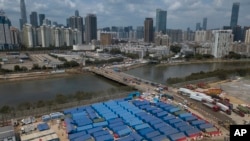A growing COVID-19 outbreak in China has pushed the number of infections reported by the government in Beijing to levels not seen in two years, leading to lockdowns in some of the country’s most economically important regions and sparking concern about another major shock to a global economy already reeling from high inflation and the war in Ukraine.
The Chinese government announced on Sunday that the southern city of Shenzhen, in Guangdong province, would be placed on lockdown for at least a week. A travel ban was placed on the northeastern province of Jilin, including the manufacturing hub city of Changchun.
On Tuesday, officials in the city of Langfang, close to Beijing, announced a new lockdown, as did officials in Dongguan, another city in Guangdong Province.
There is also evidence that the virus is spreading in other parts of the country, leading to speculation that further lockdowns may be on the horizon.
China’s so-called “zero COVID” policy, which has relied on strict lockdowns of entire regions of the country, has so far kept the country relatively safe from the kind of outbreaks that have ravaged many Western countries. However, the highly contagious omicron variant of the virus is now in circulation there, and it remains to be seen how well the country’s lockdown strategy will counter it.
Complicating factors
The increased transmissibility of the omicron variant of the virus, combined with China’s overall vaccination status, have created concern that the government will have difficulty keeping this wave under control.
A possible warning sign is Hong Kong, which has mirrored mainland China’s approach to managing the virus and which, as of Sunday, was experiencing a weekly COVID-19 death rate of 38 people per million. That is the highest rate recorded in any country at any stage of the pandemic, according to data gathered by the Financial Times.
The problem in Hong Kong is twofold. First, while Hong Kong has long had access to vaccines against the disease, a large percentage of residents over 80 years of age, who are statistically the most vulnerable, have not been vaccinated. While China’s overall vaccination rate is high, it also has a large percentage of elderly citizens who have not been vaccinated.
The second problem is that the majority of Chinese who have been vaccinated received the domestically-produced Sinovac vaccine. Sinovac, which does not use the mRNA technology that made vaccines produced by Pfizer and Moderna so effective, does not by itself provide significant protection from the omicron variant of COVID-19. Mainland China has been similarly reliant on the Sinovac jab.
Disruption feared
Early in the pandemic, lockdowns across large regions of the country contributed to massive supply chain problems and shipping bottlenecks that left major ports overwhelmed. Analysts said that the global economy could be facing more of the same if China cannot get the outbreak under control.
“The lockdown in Guangdong Province and Shenzhen is, I think, the most worrisome because it is [China’s] largest exporting province,” said Mary Lovely, a senior fellow with the Peterson Institute for International Economics. “It's a powerhouse, especially in electronics.”
Lovely said that it is difficult to predict exactly which industries will be affected by the lockdowns because of how tightly interconnected various parts of the country’s supply chain are. Even a relatively small lockdown, if it is in an area that produces a specific input for other industries, could wind up having a wide-ranging effect on overall economic activity.
Already this week, Foxconn and Unimicron Technology Corp., both major suppliers to Apple, announced that they have temporarily closed production in Shenzhen. In Jilin, a major center for car manufacturing, Toyota said it has suspended operations there, where it has a joint venture with the FAW Group, a Chinese firm. Volkswagen has also suspended production there.
A targeted approach
The hope is that China’s approach to handling the outbreak on a regional basis, rather than implementing a country-wide lockdown, might help avoid the worst economic impacts. In the past, it has successfully reopened a number of cities after relatively brief lockdowns, combined with a comprehensive regime of testing.
“The concern is the broad and lengthy shutdowns of factories will lead to supply chain chaos involving everything from iPhones to Christmas ornaments,” Doug Barry, a vice president with the U.S.-China Business Council, told VOA in an email exchange. “China officials are aware of potential damage to foreign-owned producers and buyers as well as the domestic economy. They are taking a targeted, calibrated approach. Shenzhen factories are closed for a week followed by a reassessment.”
“We’ve seen this movie before in the first year of the pandemic featuring delayed shipments, shortages of critical goods and inflation,” Barry wrote. “A [COVID-19] outbreak on a massive scale could have massive consequences, especially for U.S. consumers, whose goods for the Christmas season need to be on the water by summer.”








